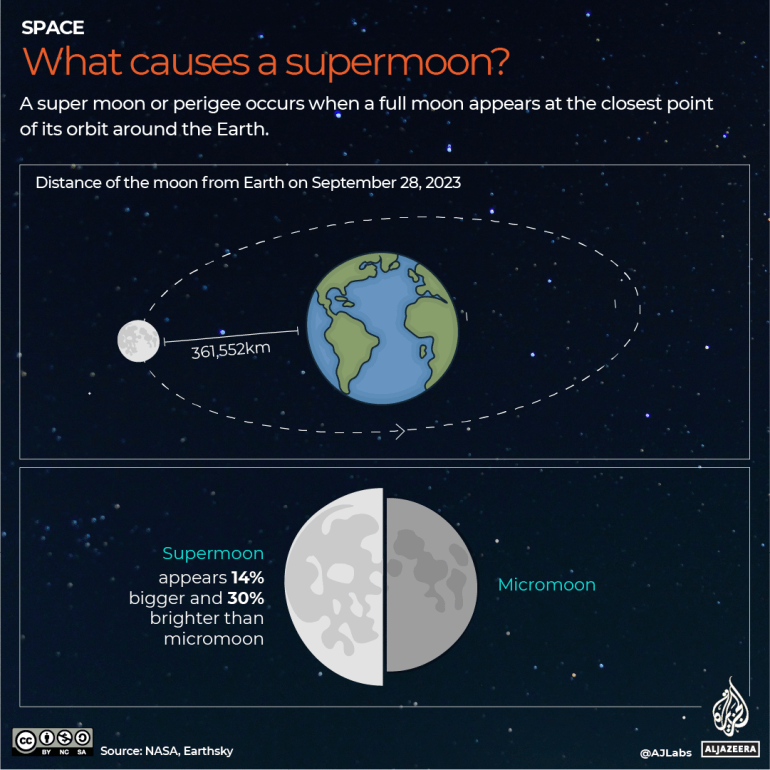
On the night of September 17, the Earth, Sun and Moon will create three celestial phenomena.
In many places, depending on the time zones, people will have the opportunity to see the harvest moon, super moon and lunar eclipse when the full moon rises.
Here’s what you need to know about these events:
First things first: What is a full moon?
According to NASA, a full moon is defined as the moment when the moon is exactly right 180 degrees Opposite to the sun. At this time, the Sun completely illuminates the Earth’s satellite.
NASA says this month’s full moon will peak at 10:35 PM EDT on Tuesday, September 17 (or 02:35 PM GMT on Wednesday, September 18).
Full moons usually rise around sunset and set around sunrise. There are eight phases of the moon’s cycle, which repeats every 29.5 days.

What is a partial lunar eclipse?
A partial lunar eclipse is when part of the full moon is covered by the Earth’s shadow.
The shadow expands and then retreats, but never reaches full phase. In contrast, during a total lunar eclipse, the Earth’s entire shadow completely covers the Moon.
The Moon will begin moving into Earth’s partial shadow at 8:41 PM EDT On Tuesday (Wednesday 00:41 GMT). The initial dimming will likely be subtle until the Moon’s upper edge begins to enter full shadow at 10:13pm EDT on Tuesday (Wednesday 02:13 GMT).
The eclipse will peak at 10:44pm EDT on Tuesday (02:44 GMT Wednesday), with only the first eight percent of the Moon in full shadow.
The moon will exit the full shadow by 11:16pm EDT (03:16 GMT) and the partial shadow by 12:47am EDT or 04:47 GMT on Wednesday morning.

What is a Super Moon?
This moon will also be a super moon.
A supermoon is defined as an astronomical phenomenon in which a full moon is larger and brighter than usual. It occurs when the full moon occurs at the same time as its orbit is closest to Earth.
According to NASA, the term “supermoon” was coined by astrologer Richard Nolle in 1979 to describe a full moon that occurs when the moon is “within 90 percent of its closest approach to Earth.”
In essence, the Earth, Moon and Sun are all in a line at this point. At the opposite end of the moon-viewing spectrum is a micromoon—when the full moon appears especially small and dim, coinciding with the point in the moon’s orbit when it is farthest from Earth.

Is this also the harvest moon?
The Harvest Moon is the closest full moon to the Northern Hemisphere’s autumnal equinox, which this year takes place on September 22 at 12:43 GMT.
Yes, this is also a harvest moon.
According to the Farmer’s Almanac, “This full moon will rise at approximately the same time Time – around sunset – for several evenings in a row.” The result is an abundance of bright moonlight in the evening.

The event traditionally helps farmers harvest their summer-grown crops by providing several extra evenings of moonlight. Hence, it is called the harvest moon.
The Harvest Moon is orange and red. It appears larger and brighter than other full moons due to an optical illusion that occurs when a moon is near the horizon.
Moonlight gets its color because it is filtered through Earth’s atmospheric particles.

So all together, how will the Martian event unfold?
- The full moon will peak at 10:35 pm EDT (02:35 pm GMT on Wednesday) on Tuesday. At this time, it reaches the peak of illumination.
- The peak of the eclipse will be at 10:44 PM EDT (02:44 GMT).
The total duration of the partial lunar eclipse is four hours and six minutes.
For viewers in the Eastern Time Zone of the United States, the eclipse will reach its darkest phase on September 17 at 10:44 PM EDT.
In Europe and Africa, the eclipse will be visible in the early hours of September 18. In the UK, the eclipse will be most prominent on September 18 at 3:44am BST.
People living in the Gulf will not be able to catch the peak of the eclipse, but they will be able to see the moment the partial eclipse begins at 05:15 am local time on Wednesday.
In the map below you can see which countries can see the peak of the Martian eclipse.

How to watch lunar eclipse and harvest moon?
If you are in the right time zone, a casual stargazer will be able to see the lunar eclipse, although it is preferable to be in dark places.
NASA Recommends Using a pair of binoculars “with a magnification of at least 7”, “a magnification of 10 or 15 will provide more detail; you may need a tripod to stabilize them.”




